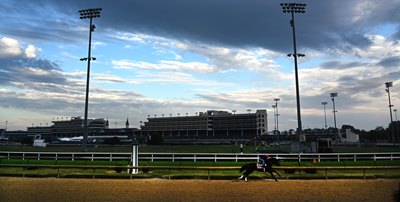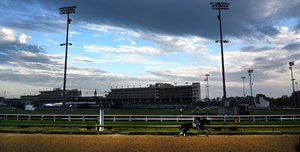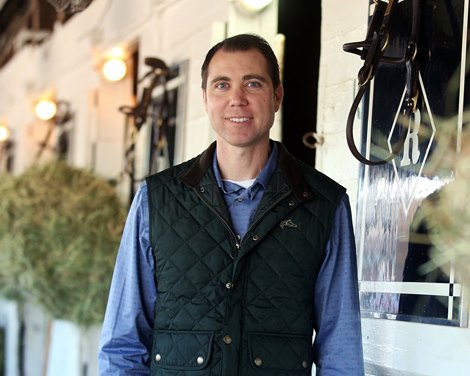Churchill Downs Starts Equine Safety Initiatives


When Churchill Downs begins its delayed spring meet May 16, the Kentucky track will also begin an era of expanded horse safety protocols.
New are a number of initiatives, first announced by Keeneland and Churchill Downs Feb. 27. Originally, the plan was to start the initiatives at Keeneland last month, but when the Lexington track canceled its spring meet because of COVID-19, Churchill Downs was left to be the first track in the state to implement the new procedures.
Those measures include pre-entry examinations by attending veterinarians within three days of entry; pre-work examinations by attending veterinarians within five days preceding a timed workout; and required examinations for horses away for extended periods by the track's equine medical director, Dr. William Farmer.
Additionally, trainers must have signed horsemen-veterinarian agreements on file with Churchill Downs and use in-today signage for entered horses.
Race-day treatment of the diuretic Lasix will not be permitted for 2-year-old racing.
The track will also utilize a waiver-claiming rule that will allow a horse off for 180 days or more to be ineligible for claim if the horse is entered for a claiming price equal to or greater than the price at which it last started.
Farmer, hired last fall by Churchill Downs Inc., has been kept busy communicating the protocols before the track opens its backstretch areas May 11.
"I've had a lot of phone calls over the last 24-36 hours, very positive, just questions about logistical things," he said. "But overall, it's been very well supported."

Farmer said one of the challenges is related to inspections of horses away for 120 days or longer, which is more common due to no racing in Kentucky since late March. Racing in some other states has been closed over that approximate time.
"A lot of these guys, through no fault of their own, have kind of had to pull back on the reins because they didn't have any options; there's no place to race for many of them," Farmer said. "So we've been working individually to work through each circumstance. And so far, I mean we haven't had any hurdles."
Though the safety changes are new for many Kentucky horsemen, they aren't for those who have raced in California. After a spike of breakdowns at Santa Anita Park in the early part of 2019, tracks in that state and the California Horse Racing Board instituted a series of sweeping reforms meant to improve safety. Since that time, the rate of catastrophic injuries there has been sharply reduced.
"We've shown in California that it can be done. Some things are different than they were in the past," said California trainer John Sadler, who will also have a 20-horse stable at Churchill Downs this spring. "The thing I have kind of learned through this process is to be proactive with the regulatory vets. So if you have a little question with a horse or something like that, you want to get them over and show them that horse. It's more steps now, but it's worked."
Not all the changes at Churchill Downs are regulations. Over the winter, the track completed construction of its equine medical center—located next to several quarantine barns—that is a part of a Churchill Downs backstretch expansion that cost $8 million. Farmer's office is located in the medical center, which can serve as a triage facility for practicing veterinarians. It has four large stalls and a general working area.
"Each stall has its own lift," Farmer said. "So if a horse needs to be hoisted for some reason, each stall has its own dedicated lift. If we need to, we can take a horse from a stall into where there is a big, open work bay area that can be used by the veterinarians."
The quarantine barns might also see action this spring, though not for their intended purpose of housing horses coming to Churchill Downs from out of the country. The barns, which were built with the intention of aiding international participation for races such as the Kentucky Derby Presented by Woodford Reserve (G1), have not yet received certification from the United States Department of Agriculture, Farmer said. In the coming weeks, they could see use as receiving barns for ship-in horses.
Due to rich purses and fewer racing options elsewhere around the country due to COVID-19, Churchill Downs officials anticipate large support for its spring racing program.
"We're just trying to anticipate what it looks like for shippers, especially the first couple of race days—how many ship-in horses—and trying to maintain social distancing," Farmer said.
The recent changes at Churchill Downs, the first of which were announced in April 2019, followed negative media coverage the track received that March after the fatalities at Santa Anita. At that time, the Courier-Journal in Louisville reported that the 16 racing fatalities at the track in 2018 was at a rate higher than 24 of 25 tracks that publicly listed their totals in The Jockey Club's Equine Injury Database. Forty-three died at Churchill while racing from 2016-18, according to the Courier-Journal.
Last year was safer for the track, according to reports issued during Kentucky Horse Racing Commission meetings. During the 2019 spring meet, for example, there were three equine deaths during racing, only one of which was from a musculoskeletal injury, compared to six equine deaths at the 2018 spring meet (five musculoskeletal and one sudden death).
Although CDI is a member of the Thoroughbred Safety Coalition, a group that has emphasized transparency, Churchill Downs and other CDI-owned tracks do not publicly disclose their racing fatalities online as part of the Equine Injury Database, as 27 tracks did in 2019. (CDI forwards its statistics to the database for overall record keeping.) The Courier-Journal obtained the figures from a public records request from the KHRC.
Now, a little more than a year after Churchill's initial announcement, a new chapter begins in Kentucky.
"Horse safety and horse welfare are some of the major issues of the day. People will learn the new regulations, and they'll adjust," Sadler said. "At the end of the day, the horsemen want to be safe. Anybody that has demonized the game—that's just not reality. Horsemen love their horses and want what's best."
